Engages,
Ros Bandt & Albert Mishriki, Rod Cooper, Emma Lashmar, Rowan McNaught The Sound Playgound
Dates: 6-17 July 2010
Featuring new commissioned sound sculptures, experimental instruments and sonic installations by Rowan McNaught, Rod Cooper, Ros Bandt & Albert Mishriki and Emma Lashmar. Curated by Amelia Douglas and Nella Themelios, produced by Timothy Webster. Presented by Bus Projects, Craft Victoria and fortyfivedownstairs as part of Liquid Architecture 2010.
The first Australian sound playground was made by Ros Bandt in 1981, in Brunswick’s Temple Park, Melbourne. Bandt’s sculptural installation was engorged with panels of musical instruments including bells, gamelan-like devices, wind and percussive elements, and was a gift from the artist to the people of Brunswick to use collaboratively, for free. The installation was enjoyed by both the local and wider communities for two years, as a site of experimentation, learning and free play.
Although Bandt’s work is an important local precursor for The Sound Playground in 2010, this new exhibition and performance series was initially sparked by Tim Webster’s proposed collaboration between Bus Projects and Craft Victoria in 2009. In thinking through the possibilities for collaboration, we pondered: What is the craft of sound or the sound of craft? And what does it now mean to create a Sound Playground some thirty years after Bandt’s original construction, at a time where both sound art and craft are simultaneously distant yet interchangeable elements of contemporary artistic practice?
The curatorial brief for this exhibition specified the construction of ‘physical objects with sonic potential’. In recent years there has been a renewed interest in object-based sound art, and a generous enthusiasm for the crafty materiality of sonic contraptions. Sound artists in this context are also builders and architects; works are constructed according to the specific properties of materials and acoustic specifics of locations. The link between the materiality of objects and the materiality of sound as it physically moves through the air becomes a source of wonder for makers and listeners alike.
We conceived of The Sound Playground as a tactile environment in which visitors could independently discover and explore the sonic potential of custom-built sound objects, as well as experience improvised performances of the works. The utilitarian activation of these objects requires patience, exploration and most of all curiosity: there is no aspect of this exhibition that can be consumed in a single glance. Triggers for activity may need time to emerge. As an ‘event exhibition’, the Sound Playground can be played in its totality but also experienced during moments of stillness – the acts of looking and listening can be separated into distinct parts and then brought back together again, as in Ros Bandt and Albert Mishriki’s music-box grotto, in which the synchronicity of sound and vision is delayed through elements of disguise and intrigue.
We were excited about the idea of bringing together artists from different backgrounds to work within the framework of the playground. Ros Bandt has created and curated countless sound installations, playgrounds, workshops, recordings and exhibitions in Australia and around the world since the 1970s. Emma Lashmar is a trained glass blower; this is her first performance-based project. Albert Mishriki’s sound sculptures and experimental instruments are often produced from salvaged materials and incorporate bastardised electronics. This is the first exhibition in which Albert’s sculptures have been specifically designed for public interaction. Rod Cooper’s practice includes painting and metallurgy; these new works are the first in what will be an ongoing series of ‘sound portraits’ for Rod. And Rowan McNaught’s practice, which has to date included installation, photography, video, and technological bricolage, has now been extended to incorporate an extra, aural dimension.
Most of the works in the Sound Playground are available for anyone to play during normal gallery hours, and the entire exhibition will be performed by the artists (together with guests Nicholas Jones, Sam Szoke-Burke and Adam Sherry) in a special series of improvised concerts in the gallery. Each performance will necessarily produce a new incarnation of the Sound Playground.
Amelia Douglas and Nella Themelios, 2010
LIST OF WORKS
Emma Lashmar “re/sonance” 2010
Piano wire, steel cable, cello bows, nylon filament, blown glass, water, wall fixtures and sound equipment.
The vast architectural space of fortyfivedownstairs defines the framework for Emma Lashmar’s site-specific string instrument. The resounding of the harp/cello-like strings as they are plucked and bowed creates an audible shadow-echo of the room. A second set of strings strung with hand-blown glass spheres filled with water vibrate in response to the sounds created. The direct physical response produced by the water within these transparent objects or bodies is a visible effect that correlates to the listeners’ experience of the sounds created.
Rowan McNaught “Manifon” 2010
Alesis trigger, aluminium, bucket, chair, copper, dowel, Edirol MA20s, foam, helmets, mat, MSI Wind U200, mover’s carpet, net, piezos, RCA to 3.5mm cable, rope, tape, USB cables, water bottles.
The Manifon is an idiophonic electro-acoustic instrument consisting of water jugs and bicycle helmets suspended on an ad-hoc frame. The ‘object keys’ are wired via contact triggers to a custom-made electronic instrument, running on a netbook computer. When a key is struck, the electronic instrument picks from a catalogue of recorded sounds and processes it through a musical tone, giving the sound a pitch. For example, the player might strike a water jug that gives the sound of a tree branch being snapped at the pitch of D#. The objects are ‘tuned’ to a pentatonic scale, which is utilised in traditional and folk music pan-globally.
Albert Mishriki and Ros Bandt “Peep Hole 2” 2010
Wood, steel, aluminium, plastic, rollerblade wheels, bicycle bell, air mattress pump, recorder mouth piece, mixing bowl, guitar bodies, biscuit tin, transducer, guitar pickups, ball bearing, egg ring, springs, door knob, music box tines, machine heads, bamboo, brass horn, guitar strings, bass string, violin string, zither strings, piano wire, hose clamps, sticky tape, fabric, LP vinyls.
This work is adapted from a site-specific installation that Ros Bandt and Albert Mishriki designed for the former premises of Bus Projects. The work was initially entitled Peephole and focused on creating intrigue (as well as offering a challenge to conventions of performance and audience expectation) by obscuring most of the action of the performance as well as the objects to be performed upon. Audience members could only catch a glimpse of movement through telescopes that penetrated the walls from adjacent rooms.
In this exhibition, the act of concealment prevails to some degree. Most of the mechanics of these music boxes and original instruments are hidden from view, with the hope of ‘bringing to light’ their primary function: the engagement of you, the potential player, in the act of listening and playing in a fervently explorative fashion. The instruments inside this room are designed to be enjoyed by people of vastly varying skill and ability and employ the simplest of movements to create a great variety of tones and timbre.
Rod Cooper “Sound Portraits” 2010
Various media including clothing, plaster, metal, speakers, turntable, fridge parts and sound
Rod Cooper’s sound portraits depict instrument builders, visual artists, musicians and sound artists at work during performance. Based on the artist’s friends and colleagues (Dale Gorfinkel, Dale Chapman, Michael Graeve, Chris Nylstoch and John Jacob), the series explores concepts of intellectual property and ownership, and asks questions about the originality of concepts in gesture, intention and execution.
Each of Rod’s subjects has donated items of personal clothing for this project. Plaster-coated T- shirts, pairs of pants and shoes capture the presence of each artist. Junk apparatus and specific choices of material provide insight about the artists’ performance style. The reciprocal exchange of dialogue and objects between Rod Cooper and his subjects creates a secondary presence in sound, material and entity.
Although the works can be manipulated live or set in automation, as a whole the installation promotes sonic and contextual improvisation. In performance, Rod’s works become re-locatable collaborations. As sculptures, they occupy space for sound and form.
Sound Playground, fortyfivedownstairs 45 Flinders Lane, Melbourne, July 6-17
All installation photographs on this website by Helen Metzger.
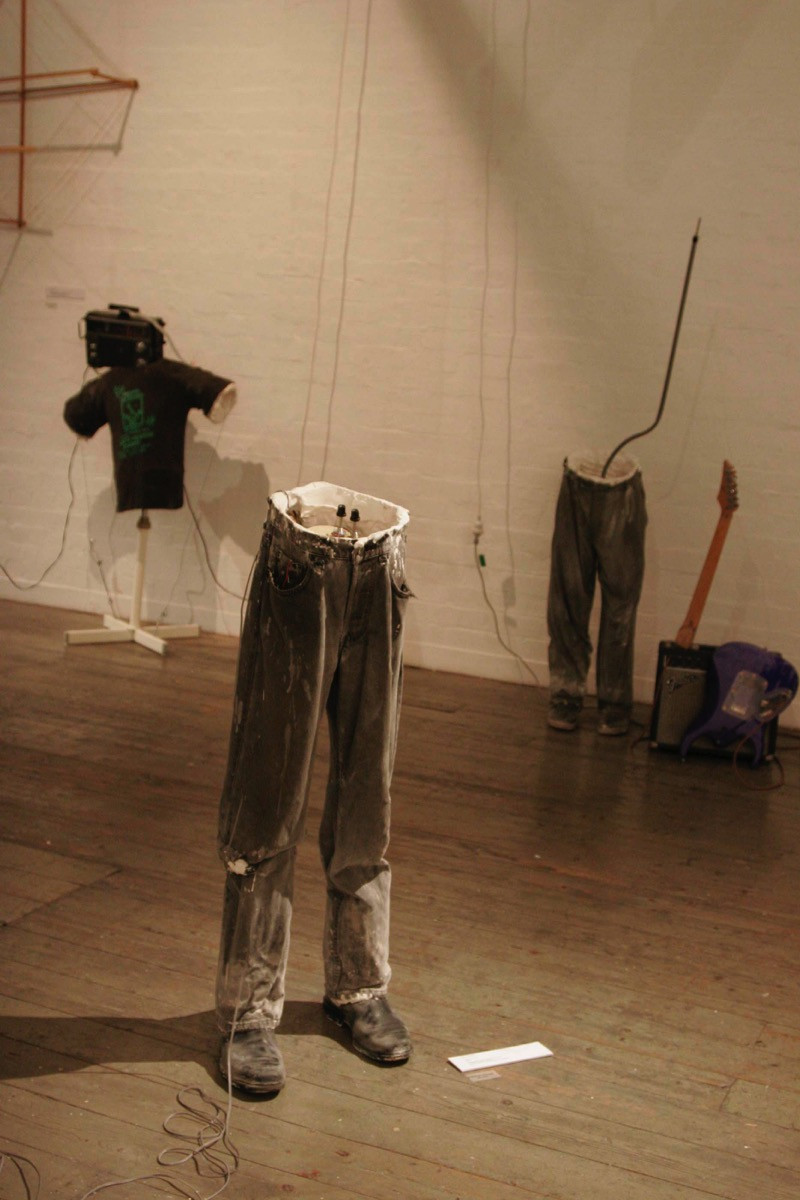
Rod Cooper
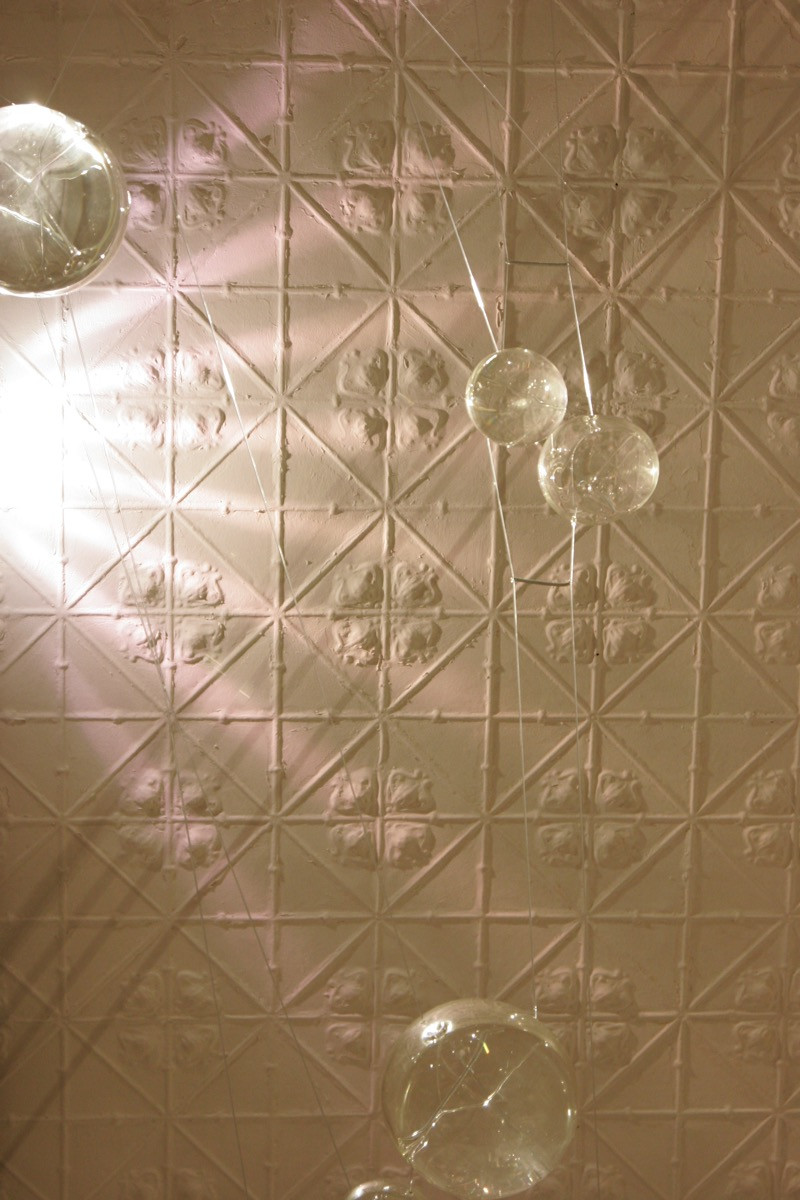
Emma Lashmar
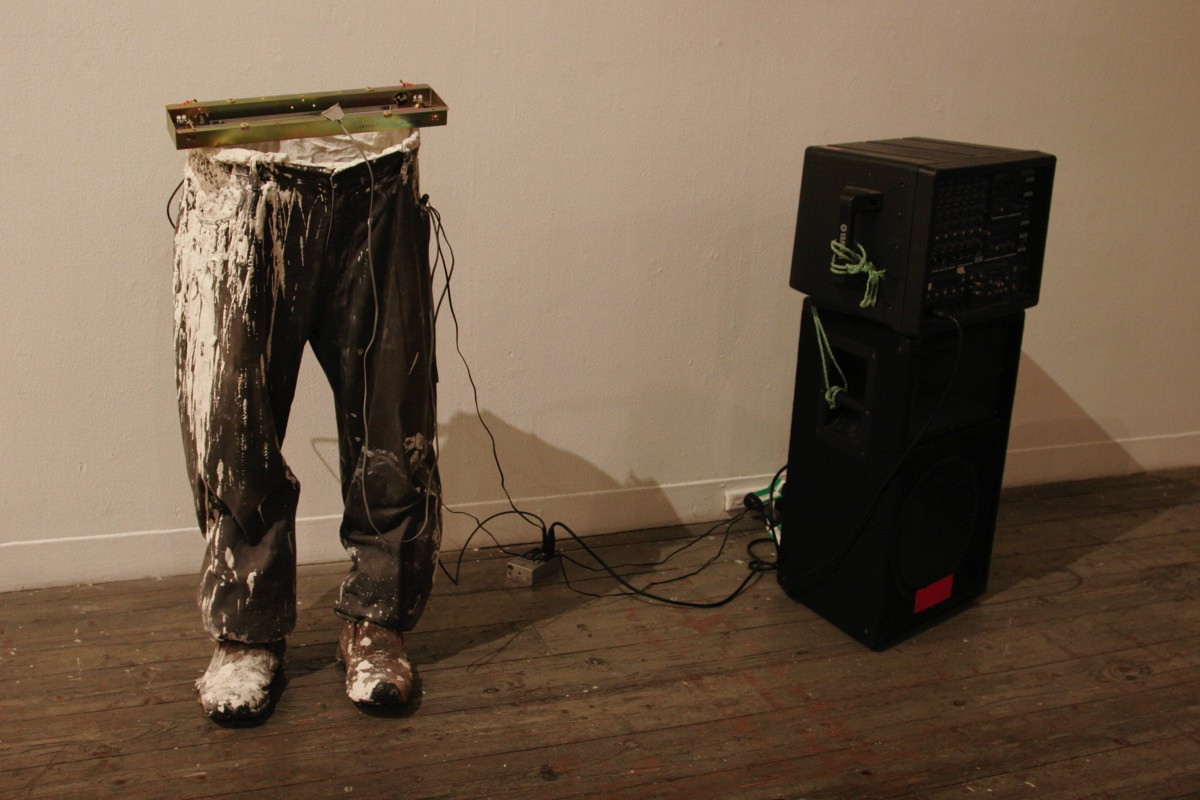
Rod Cooper
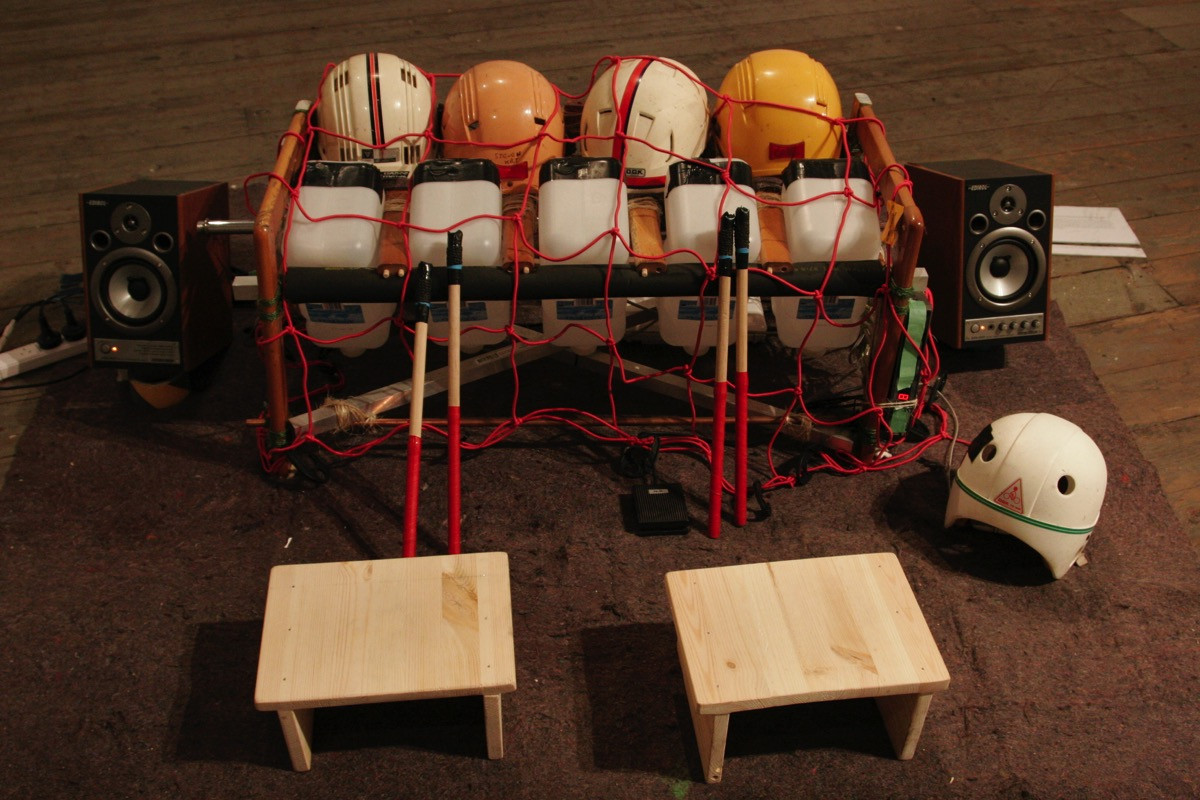
Rowan McNaught

Rowan McNaught
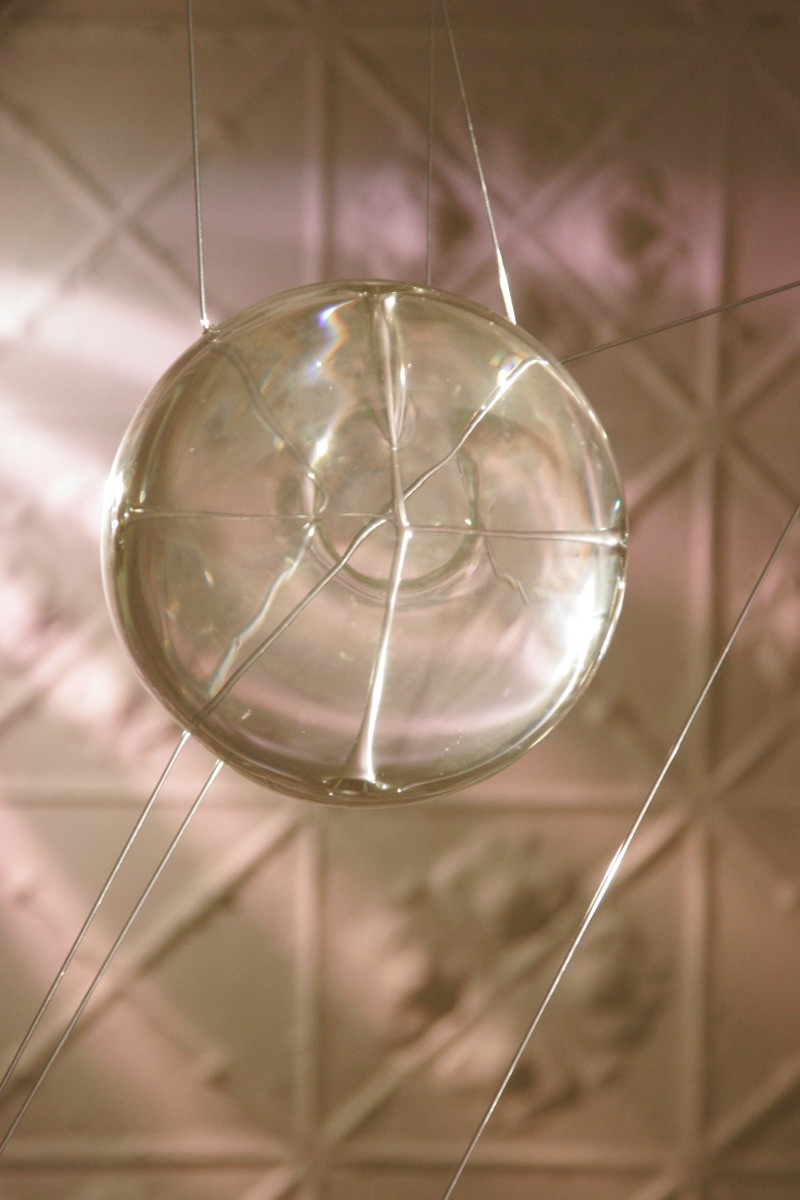
Emma Lashmar

Rod Cooper

Albert Mishriki and Ros Bandt

Albert Mishriki

Albert Mishriki